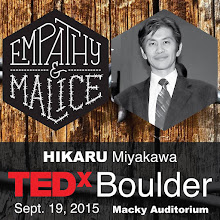He
is known in the US as "Astro Boy", but his original name is "Atom (アトム)," and
as you may know, he is an atomic energy generated/powered robot created
in the image of its creator scientist Dr. Tenma's deceased child, Tobio.
Instead of spreading the hatred and fear towards the atomic energy and its creators, the author Osamu Tezuka (手塚 治虫)
created Atom to courageously face the future of mankind and still deeply care for the humanity.
"Tetsuwan Atom / 鉄腕アトム (Mighty Atom)" was written in 1952 and made its debut on Japanese TV as a cartoon show in 1963.
I along with many of the post-WW II generations grew up watching this show and listening to its opening song written by Shuntarō Tanikawa (谷川俊太郎) as a lyricist and composed by Tatsuo Takai (高井 達雄).
I always feel energized and inspired after listening to this title song.
There is the phrase in the first verse in the title song saying, "kokoro yasashi... kagaku no ko", and that is one of the phrases
I love listening while reflecting how I am and must be towards the world.
It can roughly translated as "kind hearted, child of science".
The word,"yasashii," is usually translated as"to be kind (hearted)," but it also means "to be gentle, compassionate, and caring".
It is a revolutionary thinking to imagine the robot having compassionate, caring heart.
Instead of spreading the hatred and fear towards the atomic energy and its creators, the author Osamu Tezuka (手塚 治虫)
created Atom to courageously face the future of mankind and still deeply care for the humanity.
"Tetsuwan Atom / 鉄腕アトム (Mighty Atom)" was written in 1952 and made its debut on Japanese TV as a cartoon show in 1963.
I along with many of the post-WW II generations grew up watching this show and listening to its opening song written by Shuntarō Tanikawa (谷川俊太郎) as a lyricist and composed by Tatsuo Takai (高井 達雄).
I always feel energized and inspired after listening to this title song.
There is the phrase in the first verse in the title song saying, "kokoro yasashi... kagaku no ko", and that is one of the phrases
I love listening while reflecting how I am and must be towards the world.
It can roughly translated as "kind hearted, child of science".
The word,"yasashii," is usually translated as"to be kind (hearted)," but it also means "to be gentle, compassionate, and caring".
It is a revolutionary thinking to imagine the robot having compassionate, caring heart.
Another phrase I like is at the beginning of the second verse where it says, "mimi wo sumase, me wo mihare" which roughly means
"listen intently and watch/see/observe carefully".
At first, we are lead to think that the words are meant for Atom/Astro Boy, warning him to not to get tricked into corruption
by the enemy ("yudan wo suru na"), but soon we can realize that the words are meant for all of us.
To me it goes even beyond the "warning".
It reminds me of the compassion of Kannon/Kanzeon, the Bodhisattva who "sees" the cry(sound) of the mankind".
Let us be like Atom and be progressively caring and just.
こころ優しく、こころ正しく... ね!














